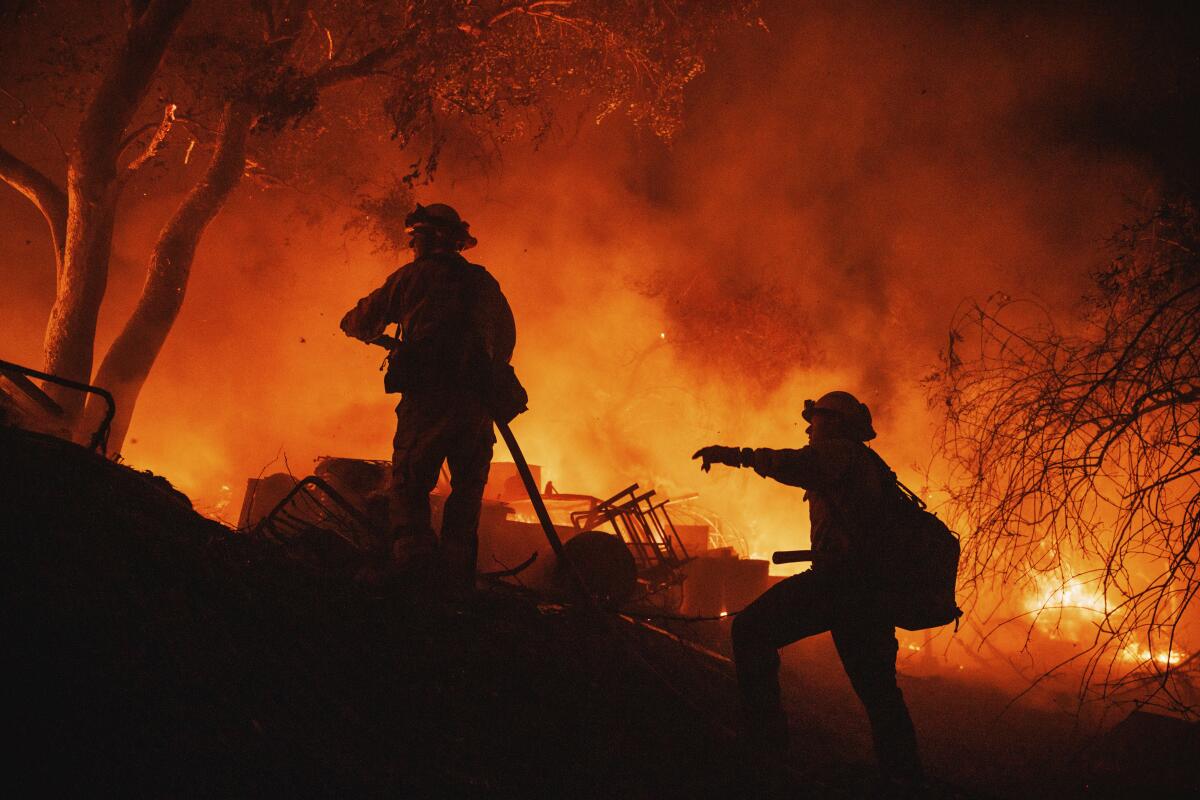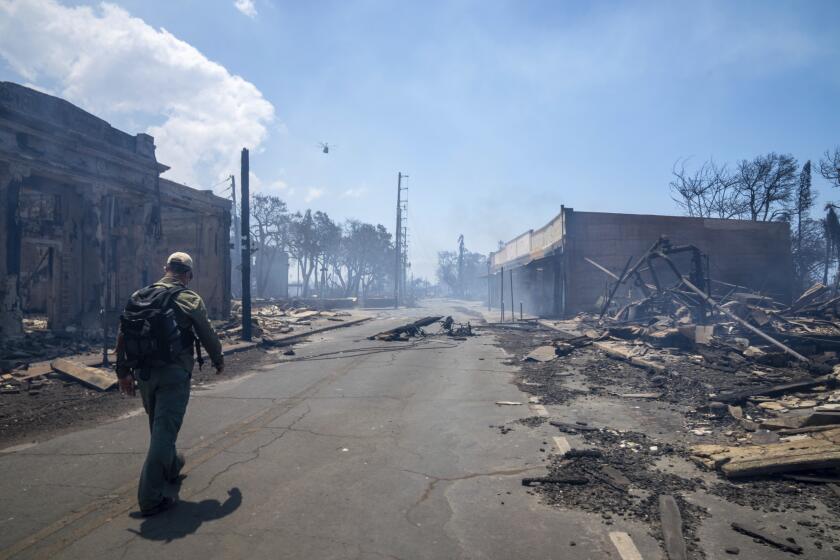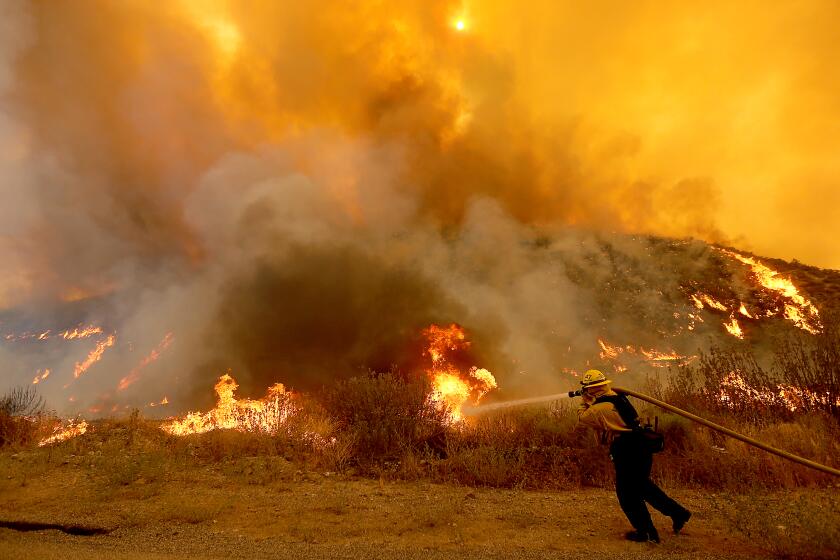No matter the weather, climate change means it’s always ‘fire season’

- Share via
In December, as rains were predicted in California, I performed the annual ritual of removing my go bag from its place in the living room and stashing it in a storage closet.
From spring until early winter the bag, filled with emergency supplies, sits just inside my front door, ready to grab in the event of a wildfire evacuation. As I put it away, I felt a wave of relief. I went outside in the clean forest air and looked up at the evergreen trees that surround my small house, and I allowed myself to admire the landscape’s beauty without fear. Fire season was finally over.
In places at high risk for wildfire, the close of fire season brings a certain peace of mind to people like me who live with constant anxiety during times of extreme weather. Each winter, fire and regional officials commence the annual ritual of declaring an end to the season. But in truth, “fire season” is more of a shorthand than a technical term with a specific definition. In Northern California, where I live, the term generally refers to the extended rain-free period between May and November when fuels are dry, moisture is low and high winds drive the spread of fires.
We survived the Paradise fire. For Lahaina survivors, escape from hell will mark them forever
The Lahaina fire survivors will need nearly everything. Much of what they’ve lost will never be replaced, and their escape from disaster will mark them forever.
The concept of fire as a season that can be predicted or a phase that will pass is outdated. In the current era of extreme weather caused by climate change, dangerous fire conditions can occur during any season. José Luis Duce Aragüés, a prescribed fire training specialist from Spain who has burned with rural communities all over the world, is fond of saying that the only thing people know for certain about fire is that “we don’t know.”
As climate change accelerates and the globe overheats, seasons themselves change. A winter forest fire burned in Big Sur in January 2022. Fire and weather professionals now acknowledge that “fire season” is no longer accurate. The term more commonly used by Cal Fire is a “fire year.”
During the 2023 fire year, the region where I live didn’t have any large-scale conflagrations. But severe fires burned in moist environs historically unaccustomed to wildfire, such as Louisiana and Hawaii. And, while we in the Northern Hemisphere are declaring fire season over, authorities in Australia are issuing catastrophic fire weather warnings and drought-fueled wildfires are burning in the Amazon.
Managing the Sierra groves for low-intensity fire, and attempting to prevent and exclude higher-intensity fire, is like managing for the extinction of giant sequoias.
The phrase that might better describe my experience of wildfire is one that’s becoming common in ecological and emergency management circles: living with fire. Beyond its literal meaning, the prospect of living with fire necessitates a deeper acknowledgment that wildfire is an essential component of the land’s cycles — an ever-present element, necessary for life.
Our ecologies here in the American West are fire-adapted. The harmful wildfires we’ve experienced in California in the past decade are the result of extreme weather fueled by climate change, combined with human development in wildland areas and 150 years of aggressive fire exclusion policies. These standards emerged in conjunction with the genocide of Indigenous people living here in the 19th century, which pushed underground the rigorous, well-tested ecological knowledge of those communities — including the regular use of intentional fire as a land management tool.
The crucial role of fire in life on Earth is something that land-based and Indigenous people all over the world have understood since time immemorial. Wildfire prevention is an important aspect of good fire, but it’s not the only one. Stoney Timmons, a Robinson Rancheria Pomo citizen and crew lead with the land stewardship organization Tribal EcoRestoration Alliance, says wildfire mitigation is a “side effect” of Indigenous cultural burning. Anthropogenic fire can keep an ecosystem healthy and regenerate important survival and cultural resources for all who live there. “We’re out here burning for the other plants and life forms, not just for fuel reduction,” he told me.
Between 1996 and 2020, wildfire burn areas in California grew five times larger than in the 25 years prior. Scientists say climate change is to blame.
The end of fire season requires a change in outlook as well as vocabulary. The relief I feel when I move my go bag away from the front door is a false sense of security, what nature writer Barry Lopez called an “unwarranted hope” in the face of the very real and rapid climate crisis.
In a best-case scenario, the present-day prospect of living with fire is an opportunity for everyone at risk from the effects of climate change — which is to say, everyone — to shift our thinking about the elements of the natural world, moving from fear and exploitation toward respect and responsibility. Lopez called this shift an expression of love. Another word for it might be relationship.
Relationships can be challenging and painful. They can contain complex power dynamics. Like a grove of redwood trees blanketed in ash, they can fill you with despair. They can also be the most beautiful part of being alive, in any season.
Manjula Martin is a writer and editor. Her book, “The Last Fire Season,” will be published Jan. 16.
More to Read
A cure for the common opinion
Get thought-provoking perspectives with our weekly newsletter.
You may occasionally receive promotional content from the Los Angeles Times.












